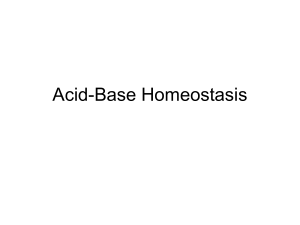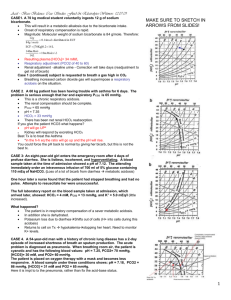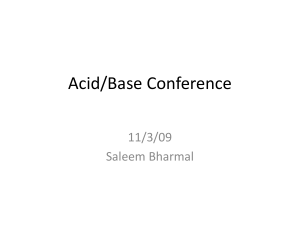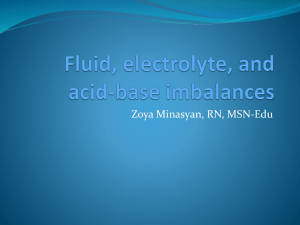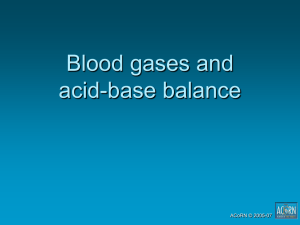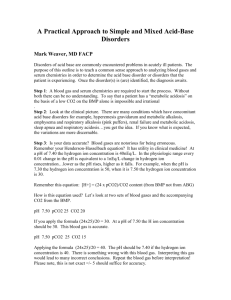Acid-Base Balance
advertisement
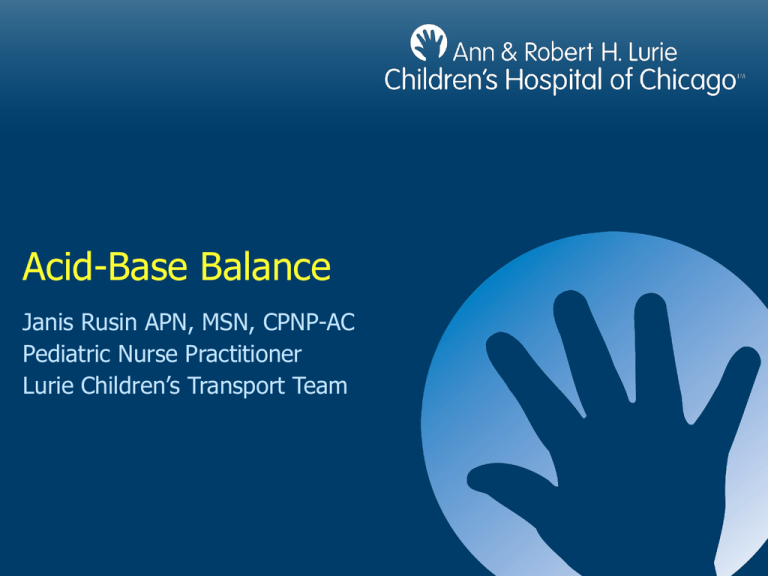
Acid-Base Balance Janis Rusin APN, MSN, CPNP-AC Pediatric Nurse Practitioner Lurie Children’s Transport Team Objectives • Discuss the mechanisms for maintaining normal acid-base balance • Define respiratory and metabolic acidosis and alkalosis • Identify the common causes of acid base imbalance • Define and differentiate between respiratory distress and failure • Discuss interventions on transport for a patient with acid-base imbalance 2 Acid-Base Balance • The human body must be maintained in a very narrow range of acid-base balance • We use pH as our measure of acidity or alkalinity • pH stands for “power” of hydrogen • Normal pH is 7.35-7.45-Not a whole lot of wiggle room! • Normal cellular metabolism occurs within this range • The 2 major organs responsible for maintaining acid base balance are: – The lungs-Respiratory balance – The kidneys-Metabolic balance 3 Chemistry Flashback! • An acid is a substance that releases hydrogen ions (when it dissociates) • A base is a substance that accepts the hydrogen ions • A buffer is a substance that protects the pH from derangements by binding with hydrogen ions HA H+ + A- 4 The Bicarbonate Buffer System • The bicarbonate buffer system is what we monitor clinically to assess acid base balance • This system works in the plasma • Relationship of carbon dioxide (CO2) to bicarbonate (HCO3-) • CO2 is the acid and HCO3- is the base 5 Balancing Act • Lungs – CO2 is an end product of normal cellular metabolism – The lungs regulate the CO2 level through respiration – Rapid response-quick fix! – The lungs cannot regulate bicarbonate levels • Kidneys – The renal tubules reabsorb bicarbonate – Excess hydrogen ions are excreted in the urine – Slower process – The kidneys cannot regulate CO2 levels 6 Clinical Applications • Acidosis (blood pH < 7.35) – A pathologic condition that causes an increase in the hydrogen ion concentration • Alkalosis (blood pH > 7.45) – A pathologic condition that causes a decrease in the hydrogen ion concentration • A simple acid base disorder has just one disturbance • The respiratory and metabolic systems compensate for each others deficiencies • If there is more than one disturbance, the patient is said to have a mixed acid base disorder 7 Types of Acid Base Disorders • • • • Metabolic Alkalosis Metabolic Acidosis Respiratory Alkalosis Respiratory Acidosis 8 Metabolic Alkalosis • An elevation in the serum pH associated with a decrease in hydrogen ion concentration and increase in bicarbonate ion concentration • Chloride plays a big role • 2 main categories – Chloride Responsive • Chloride levels are < 10 mEq/L – Chloride Resistant • Chloride levels are > 20 mEq/L 9 Metabolic Alkalosis • Chloride Responsive – Hydrogen ions are lost – Vomiting • Loss of HCL from stomach contents, as well as Na and K • Excessive NG suctioning • Loss of both Hydrogen and Chloride ions • The kidneys retain Na and K instead of H in order to maintain the Na-K pump function – Diuretics • Pull H2O from the extracellular space which is low in bicarb • Results in an increased concentration of bicarb • More bicarb available to bind with Hydrogen – Post hypercapnia • Compensation by kidneys to retain bicarb in presence of hypercapnia • Metabolic alkalosis occurs transiently once PaCO2 levels corrected 10 Metabolic Alkalosis • Chloride Resistant – Bicarbonate is retained • Hypokalemia – Low serum K causes K to shift out of the cells and H to shift into the cells • Excessive base intake – Antacids • Hypertension – Aldosterone levels are elevated – Results in Na and H2O retention – Hydrogen and excess K are dumped by kidney – K shifts into cells 11 Metabolic Acidosis • A decrease in pH associated with a low serum bicarbonate concentration • Three primary mechanisms: – Bicarbonate is lost form the body – Kidney function is impaired and acid cannot be excreted properly – Endogenous or exogenous addition of acid to the body • Common Diagnoses leading to MA – Diarrhea – Insulin Dependent Diabetes Mellitus (IDDM) – Lactic Acidosis • Poor perfusion and shock – Renal Failure 12 Metabolic Acidosis • Diarrhea – Most common cause of MA – Bicarbonate is lost in excessive stool – The kidneys are unable to keep up with the losses – Potassium is also lost in the stool – Volume depletion results in aldosterone release – Sodium is retained leading to further loss of K – Hypokalemia results 13 Metabolic Acidosis • Diabetic Ketoacidosis – Insulin deficiency occurs stimulating the release of excess glucagon – Glucagon stimulates the release of fatty acids from triglycerides – Fatty acids are oxidized in the liver to ketone bodies, betahydroxybutrate and aceto-acetic acid – These acids result in MA – In addition, the DKA patient become volume depleted due to excessive urination – Shock develops and further exacerbates the acidosis 14 Metabolic Acidosis • Lactic acidosis – Hypoxia or poor tissue perfusion – Cells are forced into anaerobic metabolism producing lactic acid • Shock • Excessive exercise • Ethanol toxicity – Ethanol interferes with gluconeogenesis – Anaerobic metabolism • Renal Failure – Distal RTA • Failure of the distal tubule to properly excrete hydrogen ions – Fanconi syndrome • Failure of the proximal renal tubule to reabsorb bicarbonate, phosphate and glucose • Causes include: – Genetics – Medications such as tetracycline and antiretrovirals – Lead poisoning 15 Anion Gap • Calculation that determines the gap between concentrations of positive (cations) and negative (anions) ions • Useful in determining the cause of metabolic acidosis • Calculated by: – (Na+ + K+) – (HCO3- + Cl-) = 10-12mEq/L 16 Anion Gap • Normal Anion Gap • The loss of bicarbonate is compensated for by the retention of chloride • Also known as Hyperchloremic Metabolic Acidosis – Diarrhea – Renal Failure, Proximal RTA • Elevated Anion Gap • MA due to increased H+ load • MUDPILES – – – – – – – – Methanol Uremia DKA Propylene Glycol Isoniazid Lactic Acid Ethylene Glycol (antifreeze) Salicylates 17 Respiratory Alkalosis • A condition in which the carbon dioxide content is significantly reduced (hypocapnia) • Caused by: – – – – – Hyperventilation Occurs within minutes of onset of hyperventilation Pulmonary disease CHF Hypermetabolic states • Fever • Anema • Hyperthyroid 18 Respiratory Acidosis • Occurs when ventilation of CO2 is inadequate and CO2 is retained (hypercapnia) • Causes include airway obstruction, respiratory depression, pneumonia, asthma, pulmonary edema, chest trauma • The renal buffer system is not effective for acute RA • Chronic respiratory acidosis can be well compensated for by the kidneys 19 So, how do we make the diagnosis? • Arterial Blood Gas-Normal Values • • • • • pH (7.35-7.45) PCO2 (35-45) PO2 (80-100) HCO3 (22-26) Base Excess/Deficit (-2 to +2) • Venous Blood Gas-Normal Values • • • • • pH (7.31-7.41) PCO2 (40-50) PO2 (35-40) HCO3 (22-26) Base Excess/Deficit (-2 to +2) 20 Blood Gas Analysis • Step 1: Look at the pH – < 7.35 is acidic – > 7.45 is alkalotic • Step 2: Look at the PCO2 – <35 is alkalotic – > 45 is acidic • Step 3: Look at the HCO3 – < 22 is acidic – > 26 is alkalotic • Step 4:Match the pH to either the PCO2 or HCO3 – Whichever one goes in the same direction as pH determines the primary disorder – Respiratory = CO2 – Metabolic = HCO3 • Step 5:Which one goes in the opposite direction of the pH? – This is the compensatory system • Step 6: Look at the PO2 – Determines presence of hypoxia 21 Blood Gas Analysis Blood Gas Interpretation Respiratory Acidosis Metabolic Alkalosis 26 HCO3 45 Normal Values 22 PaCO2 35 Metabolic Acidosis Respiratory Alkalosis pH 7.35-7.45 Acidemia Alkalemia 22 Mixed Acid Base Disorders • When to suspect a mixed acid base disorder: – The expected compensatory response does not occur – Compensatory response occurs, but level of compensation is inadequate or too extreme – Whenever the PCO2 and HCO3 become abnormal in the opposite direction. – In simple acid base disorders, the direction of the compensatory response will always be in the same as the direction of the initial abnormal change. – pH is normal but PCO2 or HCO3- is abnormal • General rule: – If the pCO2 is elevated and HCO3 is reduced, then both respiratory and metabolic acidosis are present – If the pCO2 is reduced and the HCO3 is elevated, then both respiratory and metabolic alkalosis are present 23 Respiratory Distress • A compensated state in which oxygenation and ventilation are maintained – Define oxygenation and ventilation – How will the blood gas look? • Characterized by any increased work of breathing – Flaring, retractions, grunting – What is grunting? 24 Respiratory Failure • Compensatory mechanisms are no longer effective • Inadequate oxygenation and/or ventilation resulting in acidosis – Abnormal blood gas with hypercapnia and/or hypoxia – Will begin to see decreasing LOC due to hypercapnia • Medical emergency! Must protect airway! • Strongly consider intubation 25 Respiratory Failure-Causes • Pulmonary Causes – – – – – – – Diffusion impairment Atelectasis Pneumonia Bronchiolitis Acute lung injury Pulmonary edema Shunting and V/Q mismatch • Non-Pulmonary Causes – Respiratory muscle compromise or fatigue – Impairment of the nervous systems control of breathing • Guillain-Barre • Muscular Dystrophy • Central hypoventilation syndrome – Sedatives – Head injury – Upper airway obstructions 26 Indications for intubation • Inability to protect airway – No cough or gag • • • • • Decreasing LOC GCS < 8 Cardiac or respiratory arrest Acute respiratory acidosis Refractory hypoxemia despite 100% FiO2 27 Goals of ventilation • Correct acidosis • Rest the respiratory muscles • Correct hypoxemia – Allows for delivery of high FiO2 – PEEP • Improves cardiac function – Decreases preload – Decreases metabolic demand 28 Initial Ventilator settings Volume Control Pressure Control Rate Normal for age Normal for age Tidal Volume 8-10 cc/kg PEEP Start at 5cm H2O and increase as clinically indicated i-Time Pressure Control Start at 5cm H2O and increase as clinically indicated 1:2 (Must increase E-time in obstructive processes to avoid air trapping) Set pressure to produce adequate chest rise and TV’s (8-10/kg) 29 Correction of hypoxia and hypercarbia To increase PaO2 To decrease PaCO2 Increase FiO2 Increase Rate Increase PEEP Increase Tidal Volume or Pressure control Increase I-Time 30 Match the Gas • Which patient does this gas belong to? • pH 7.09 PCO2 98 PO2 218 HCO3 30 – A) 22 y/o with Muscular Dystrophy. Severe and worsening muscle weakness – B) 9 y/o with new onset Diabetic Ketoacidosis – C) A 30 y/o patient presenting with a panic attack – D) A 25y/o in a skiing accident presenting in respiratory distress 31 Match the Gas • pH 7.09 PCO2 98 Po2 218 HCO3 30 – A) 22 y/o with Muscular Dystrophy. Severe and worsening muscle weakness – Chronic Respiratory Failure – Uncompensated Respiratory Acidosis 32 Match the Gas • Which patient does this gas belong to? • pH 7.55 PCO2 28 PO2 63 HCO3- 23 – A) 22 y/o with Muscular Dystrophy. Severe and worsening muscle weakness – B) 9 y/o with new onset Diabetic Ketoacidosis – C) A 30 y/o patient presenting with a panic attack – D) A 25y/o in a skiing accident presenting in respiratory distress 33 Match the Gas • Which patient does this gas belong to? • pH 7.55 PCO2 28 PO2 63 HCO3- 23 – C) A 30 y/o patient presenting with a panic attack – Hyperventilation – Uncompensated Respiratory alkalosis 34 Match the Gas • Which patient does this gas belong to? • pH 6.94 PCO2 26.6 PO2 55.7 HCO3 5.7 BD -27 – A) 22 y/o with Muscular Dystrophy. Severe and worsening muscle weakness – B) 9 y/o with new onset Diabetic Ketoacidosis – C) A 30 y/o patient presenting with a panic attack – D) A 25y/o in a skiing accident presenting in respiratory distress 35 Match the Gas • pH 6.94 PCO2 26.6 PO2 55.7 HCO3 5.7 BD -27 – B) 9 y/o with new onset Diabetic Ketoacidosis – DKA – Uncompensated Metabolic Acidosis 36 Match the Gas • Which patient does this gas belong to? • pH 7.27 PCO2 54.8 PO2 70 HCO3 26 BD -1 – A) 22 y/o with Muscular Dystrophy. Severe and worsening muscle weakness – B) 9 y/o with new onset Diabetic Ketoacidosis – C) A 30 y/o patient presenting with a panic attack – D) A 25y/o in a skiing accident presenting in respiratory distress 37 Match the Gas • pH 7.27 PCO2 54.8 PO2 70 HCO3 26 BD -1 – D) A 25y/o in a skiing accident presenting in respiratory distress – Acute Respiratory Distress – Uncompensated Respiratory Acidosis 38 Questions? 39

